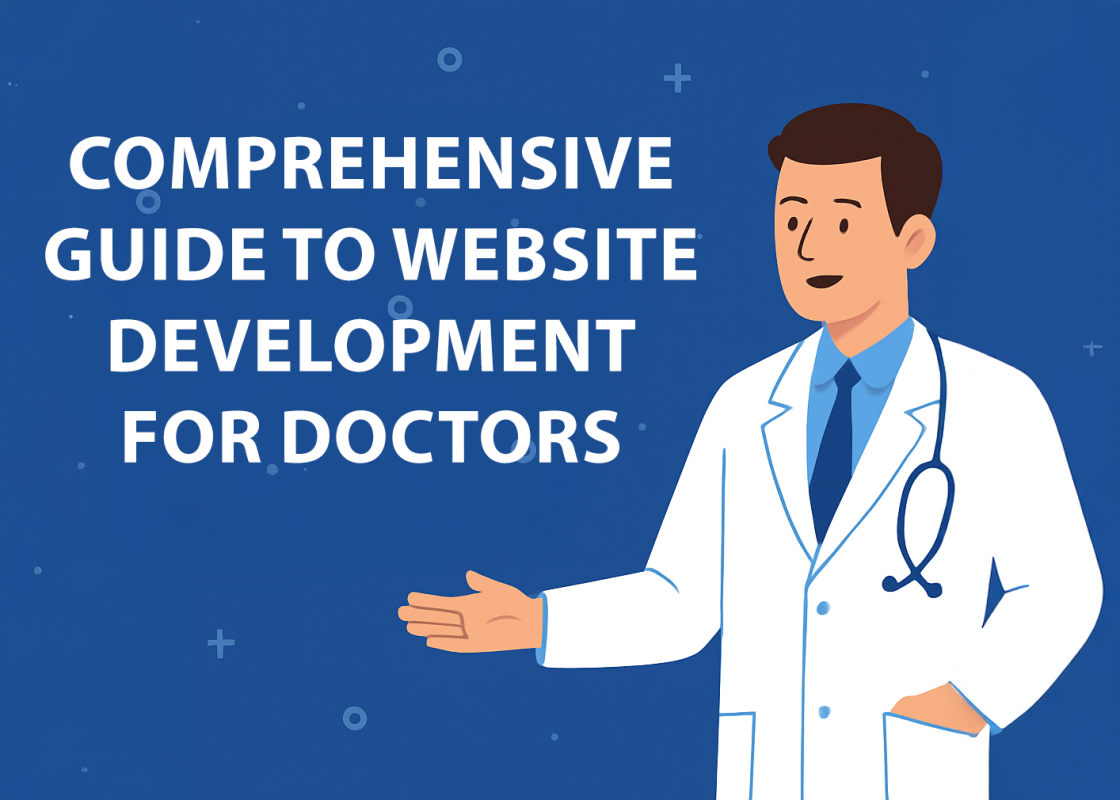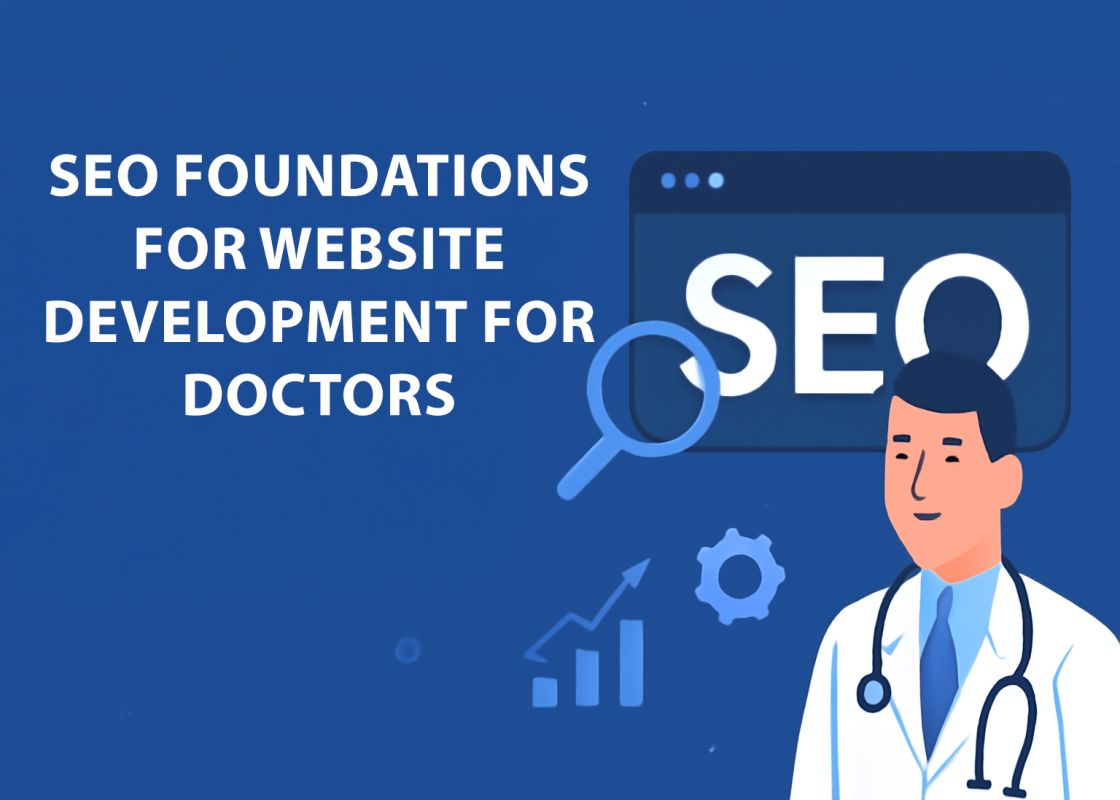Blog
Comprehensive Guide to Website Development for Doctors

Website development for doctors is more than a digital presence—it’s an operational necessity. From HIPAA-compliant form integrations to intuitive UI/UX design that caters to diverse patient demographics, a doctor’s website must perform on multiple fronts. For business owners, healthcare executives, and medical contractors, investing in tailored doctor website design strategies not only helps drive patient acquisition but also supports long-term growth, brand credibility, and lead generation.
This in-depth guide outlines the technical components, design strategies, and seo doctor implementation steps needed to ensure your medical practice’s website is not just functional, but fully optimized for performance, discoverability, and compliance.
Why Website Development for Doctors Requires a Specialized Approach
Boost Your Rankings with Expert SEO Services
Improve your website’s search performance and drive more traffic with custom organic SEO strategies and high-conversion website design.
Get Your Free SEO & Website Audit 0 businesses improved online results using our organic SEO services last week
0 businesses improved online results using our organic SEO services last week
The healthcare industry operates under a strict regulatory environment. Beyond aesthetics and responsiveness, website development for doctors must address privacy standards, accessibility requirements, and usability considerations unique to patients and healthcare providers.
HIPAA Compliance and Data Handling
Medical websites frequently collect Protected Health Information (PHI) through contact forms, appointment requests, or patient portals. Any breach in handling this data can result in severe penalties. Here’s how to mitigate those risks during development:
Best Practices:
- Use SSL certificates to encrypt data transmission (HTTPS).
- Route form submissions through HIPAA-compliant CRM systems (e.g., LuxSci, Paubox).
- Avoid using email for storing or forwarding PHI unless encrypted.
- Host the website with a provider willing to sign a BAA (Business Associate Agreement).
Sample HTML: HIPAA-Safe Contact Form Placeholder
<form action="/secure-intake" method="POST">
<label for="fullName">Full Name:</label>
<input type="text" id="fullName" name="fullName" required>
<label for="phone">Phone Number:</label>
<input type="tel" id="phone" name="phone" required>
<label for="reason">Reason for Visit:</label>
<textarea id="reason" name="reason"></textarea>
<button type="submit">Submit</button>
</form>
Important: This form must be connected to a secure backend with encryption and stored only on HIPAA-compliant infrastructure.
Accessibility Compliance (ADA & WCAG)
Accessibility isn’t just a recommendation—it’s enforceable under the Americans with Disabilities Act (ADA). Proper doctor website design ensures all patients, including those with visual or motor impairments, can access and navigate the site easily.
Actionable Tips:
- All images should include
altattributes. - Use color schemes with sufficient contrast (e.g., dark blue on white).
- Keyboard navigation must be fully functional.
- Use ARIA landmarks and semantic HTML5.
Medical Content Structure and Patient Journey
The user flow of a medical website must reflect the real-life patient experience. From learning about symptoms to booking an appointment, every step should be logical and efficient.
Suggested Site Structure:
- Home
- About the Practice / Physicians
- Services by Specialty
- Patient Resources (Insurance, Forms, FAQs)
- Secure Appointment Scheduling
- Blog or Education Portal
- Contact / Location / Hours
Each of these pages should be structured with clear H1-H3 tags, breadcrumb navigation, and schema markup for local SEO.
Key Components of Effective Doctor Website Design

Doctor website design must balance medical professionalism with consumer usability. The layout, performance, and scalability of a healthcare website directly influence how potential patients perceive your brand—and whether they convert.
Mobile-First and Responsive Architecture
Over 70% of healthcare-related searches occur on mobile devices. Your site must adapt seamlessly to different screen sizes without sacrificing usability.
Technical Strategy:
- Use media queries in CSS to define breakpoints for smartphones, tablets, and desktops.
- Minimize load time by deferring offscreen image loading and compressing resources.
- Avoid fixed-width elements that break layout on small screens.
Sample CSS Snippet: Responsive Grid Layout
.container {
display: grid;
grid-template-columns: 1fr 1fr;
gap: 20px;
}
@media (max-width: 768px) {
.container {
grid-template-columns: 1fr;
}
}
This simple structure ensures dual-column layouts collapse elegantly on mobile devices.
Navigation Simplicity and Intuitiveness
Doctor websites must avoid complex navigation systems that confuse older patients or users with disabilities. Use clear, concise menu labels (e.g., “Request Appointment,” not “Engage With Us”). Avoid dropdown menus with more than two levels.
Best Practice:
- Always use sticky headers.
- Include a prominent CTA (Call-to-Action) like “Book Now” in the navigation bar.
- Implement breadcrumb navigation for multi-page service hierarchies.
Secure Hosting and Performance Optimization
Site performance isn’t just a user experience issue—it’s also a Google ranking factor. Hosting infrastructure should be selected for speed, uptime, and security.
| Hosting Feature | Recommendation |
|---|---|
| Uptime Guarantee | 99.9% or higher |
| Server Type | VPS or dedicated (not shared) |
| Data Center Location | US-based for HIPAA compliance |
| CDN Integration | Cloudflare or Fastly |
| SSL Certificate | Required (Let’s Encrypt or higher) |
Pro Tip: Use performance auditing tools like Google PageSpeed Insights and GTmetrix regularly.
SEO Foundations for Website Development for Doctors

Building the site is only half the battle. Without seo doctor strategies in place, even the best-designed website won’t rank or attract traffic.
Keyword Strategy and Mapping
Every service page on the site should target a specific keyword and intent. Avoid cannibalization—where multiple pages compete for the same keyword—by planning keyword-to-URL mapping in advance.
Example Mapping:
/services/dermatology→ dermatologist in [City]/services/pediatrics→ pediatrician [City] accept new patients/blog/flu-vaccine-importance→ should I get flu vaccine
Use schema markup (e.g., MedicalClinic, Physician) to further reinforce topical relevance.
Technical SEO: Structuring for Indexing and Speed
Implement best practices to ensure your doctor website is indexable and efficient:
- Meta Tags: Unique title and meta description for every page.
- Sitemap.xml: Submit to Google Search Console.
- robots.txt: Avoid accidental blocking of key assets.
- Schema Markup: Use JSON-LD for medical business info, FAQs, and reviews.
- Image Optimization: Use
webpformat andlazy-loading.
Sample JSON-LD Schema for Local Business:
<script type="application/ld+json">
{
"@context": "https://schema.org",
"@type": "MedicalClinic",
"name": "Dr. Sarah Peterson Pediatrics",
"address": {
"@type": "PostalAddress",
"streetAddress": "123 Health Ave",
"addressLocality": "Austin",
"addressRegion": "TX",
"postalCode": "78701"
},
"telephone": "+1-512-555-0199"
}
</script>
On-Page Content Structure
Every page must use semantic HTML5 structure: only one H1 per page, with cascading H2, H3, etc., below. Incorporate primary and secondary keywords naturally in body text, headings, and alt tags.
Role of Blogging in Website Development for Doctors
Content plays a major role in both patient education and organic SEO. Regularly publishing high-quality, medically accurate blog posts can help establish your practice as a local authority.
Topic Selection Strategy
Use tools like Google Search Console or free keyword tools to identify high-volume, low-competition queries. Ideal content formats include:
- Symptom-focused (e.g., “What causes chest pain?”)
- Seasonal (e.g., “Why allergy season worsens in spring”)
- Preventative care (e.g., “How often should I get a physical?”)
Important: All content must be fact-checked and ideally reviewed by licensed medical professionals.
Internal Linking Structure
Link blog posts to relevant service pages using keyword-rich anchor text. For example:
“For treatment options, see our dermatology services page.”
Use sidebar widgets to promote recent posts, FAQs, or appointment CTAs.
Implementing Local SEO in Website Development for Doctors
A key aspect of seo doctor strategy is optimizing for local visibility. Patients search for practitioners “near me” or in specific cities—your site needs to rank for those queries to stay competitive.
Google Business Profile Optimization
Creating and optimizing a Google Business Profile (formerly Google My Business) is one of the fastest ways to increase visibility in local search packs.
Checklist:
- Exact business name and NAP (Name, Address, Phone) must match your website.
- Add service categories like “Pediatrician,” “Cardiologist,” or “Family Medicine Physician.”
- Include operating hours, photos, accepted insurance, and appointment URLs.
- Actively respond to reviews and enable messaging features.
Local Citations and Directories
Submit your practice to relevant directories like Healthgrades, Zocdoc, Vitals, and Yelp. Ensure consistent data formatting across platforms—use a tool like Yext or Whitespark if managing manually is too labor-intensive.
Geo-Targeted Landing Pages
For multi-location practices, create separate pages for each geographic area you serve, using unique content and embedded maps.
Example URL Structure:
/locations/san-diego-family-medicine/locations/oceanside-pediatrics
These should include schema markup, location-specific keywords, and locally hosted reviews.
Analytics, Conversion Tracking, and Lead Generation

A successful website development for doctors strategy must include measurable KPIs and real-time tracking systems to assess performance and drive ROI.
Tracking Essential Metrics
Integrate Google Analytics 4 (GA4) and Google Tag Manager (GTM) to monitor user behavior.
Key Metrics to Track:
- Appointment conversions
- Click-to-call actions
- Time on service pages
- Referral sources (organic, paid, social)
Conversion-Focused Design Tactics
Use strategically placed CTAs throughout the site. Every scroll-depth zone (top, mid, bottom) should contain an option for the visitor to take action.
Examples:
- Sticky “Book Now” button
- Exit-intent popups offering appointment reminders
- Minimal-form appointment requests (Name, Phone, Reason)
Avoid overloading forms with too many fields. Each additional field decreases completion rate by up to 20%.
A/B Testing for UX Optimization
Use tools like Hotjar or Crazy Egg to test different versions of headers, form placements, or CTA colors. Over time, optimize pages based on heatmap data and user flows.
Security, Maintenance, and Scalability
Ongoing support and protection are vital for any healthcare site.
Maintenance Tasks Checklist
Regular maintenance keeps your doctor website secure and performing at optimal speed.
| Task | Frequency |
|---|---|
| CMS & plugin updates | Weekly |
| SSL certificate check | Monthly |
| Backup schedule verification | Weekly |
| Form and script testing | Quarterly |
| ADA/WCAG re-evaluation | Annually |
Implement uptime monitoring using tools like UptimeRobot and secure backups using solutions like CodeGuard.
Protecting Against Cybersecurity Threats
Medical sites are frequent targets for attackers. Use a Web Application Firewall (WAF), enable two-factor authentication for admins, and avoid storing any PHI on the web server.
Consider implementing:
- DDoS mitigation via Cloudflare
- Encrypted database storage (at rest and in transit)
- ReCAPTCHA for all public-facing forms
Final Thoughts on Strategic Website Development for Doctors
Proper website development for doctors involves far more than attractive visuals or modern layout. It requires rigorous compliance, intelligent architecture, scalable infrastructure, and deeply integrated SEO methodologies. By following the principles and tactics outlined in this guide, business owners, medical contractors, and CEOs can ensure their sites serve as both a powerful patient acquisition tool and a trusted medical resource.
Whether you’re launching a new practice or modernizing a legacy website, integrating these elements will lead to better search visibility, higher patient trust, and sustainable growth.
Elevate Your Business with Organic SEO & Web Design
Drive high-quality traffic and increase conversions with expert **organic SEO services** and fast, responsive website design crafted to meet your business goals.
Book Your Free SEO & Website ReviewFAQ: Natural SEO Services for Healthcare Professionals
Here are five high-volume search questions and answers designed to help business owners and healthcare providers understand and evaluate natural SEO solutions:
What are natural SEO services and how do they differ from paid advertising?
Natural SEO services focus on improving a website’s ranking in organic (unpaid) search engine results through content optimization, technical improvements, and link building. Unlike paid ads (PPC), natural SEO builds long-term authority and continues generating leads without ongoing ad spend.
How long does it take to see results from SEO for a medical website?
Typically, noticeable improvements appear within 3 to 6 months. Competitive markets or newly launched domains may take longer. Factors such as domain authority, existing backlinks, and technical structure influence the speed of success.
How much does it cost to develop a doctor’s website and invest in SEO?
Basic doctor website design can range from $3,000 to $10,000+, depending on features like patient portals, form integrations, and HIPAA compliance. Monthly seo doctor services typically range between $750 to $3,000, depending on market size and scope.
Why is SEO important for doctors and medical practices?
Search engine visibility is critical for attracting new patients. The majority of users choose providers found on the first page of Google. Without strong seo doctor implementation, your website risks being invisible—even if it’s technically excellent.
Can I do SEO for my medical practice myself, or should I hire an expert?
While basic SEO steps can be self-managed, effective website development for doctors and healthcare SEO often involve technical expertise and compliance knowledge. Working with a professional ensures alignment with search algorithms, patient privacy laws, and competitive positioning.